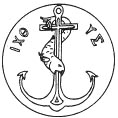Diakon Studies
for
Church of the Way,
the Ekklesia Epignostika, a Church of Esoteric Kristian
Mysteries
|
Depicted above is the ancient Fish symbol scratched in the sand, much the way early Christian initiates did to identify each other. Both Christians and “pagans,” revered this symbol. Read more about it here: Ichthys, the Jesus Fish. You might also be intrigued by some of the many articles which come up |
What is a Diakon?Diakon Lesson 1 Sacred Gender BalanceDiakon Lesson 2 Egyptian Religion and Its Co-Relation to Judaism & Christianity Diakon Lesson 3 Diakon Lesson 4 Diakon Lesson 5 |
Please note: You only have to do each lesson once. No need to repeat any lesson on this page (or anywhere else in the Mystery School) if you already completed it in another Mystery School study hall.
What is a Diakon or Diakonissa?
Top
The Diakons and Diakonissas are the officers of the Church. Later they came to be considered the elders of the Church, but in the early Church a person did not have to be old to hold this special office!
Whether you are male or female the following website will tell you a lot about the role of deacons and deaconesses in the early church. Dig thru the evidence on this
website about women being sacramentally ordained as deacons.
Your Ordination as a Diakon/issa. To become a Diakon/issa you need to be ordained. As soon as you have completed the 1st Degree Study Hall you are working on, AND the requirements on this page,
send us an email requesting ordination as a Diakon or Diakonissa in the Church of the Way. Be sure to put “Diakon/issa Ordination Request” in the subject line. (You may wish to copy the email to KatiaRoma@aol.com so that Bishop Katia will see it sooner).
Study this Ordination ceremony of both a Diakon & Diakonissa in ancient manuscripts, which proves both males and females were granted this title. It also shows similarities to our Church of the Way Diakonate Ordination rite.
What’s next in the Church of the Way?
After Diakon, the next “rank” in the Church of the Way is Arch-Diakon/issa, follow by the priesthood itself where a female priest is called a presvytera and a priest is called presvyter. This Greek word is actually the origin or our English word “priest” and “priestess,” and is the root of the word Presbyterian, which means “priestly.” Our Church of the Way uses Greek words like Catechumen, Diakon, Presvyter for these titles. This is exactly as was done in the early church.
Yeshua spoke Greek, most scholars agree, but he probably would have used Hebrew or Aramaic words for these officers of the Church, IF he had founded a “church” per se with a working congregation. We shall never know because Yeshua operated a traveling Mystery School while he walked the earth, not a “church” with a congregation. There is evidence his group met in house churches in Capernaum (Peter’s hometown) and Bethany in Lazarus’ house, and he may have ordained a few diakons and diakonissas. The Charge he delivered at the Last Supper, “do this in remembrance of me,” which took the Eucharist to a whole new level, was the foundation of the new priest/ess/hood of the Church of the Way. That new priesthood, founded at the Last Supper, had/has a different emphasis from when Yeshua was personally working with and teaching his students. Our priest/ess/hood carries on that original Charge.
Church of the Way

Ecclesiastical Degrees
The Catechumenate
Order of Catechumen
The Ecclesia (Church Body)
Credant of the Way, aka Believer
The Clergy Minor Orders
0. The Order of Cleric (aka Tonsure)
1. The Order of Porter (aka Doorkeeper & Bellringer) (The Ostiarate)
2. The Order of Lector (aka Reader) (The Lectorate)
3. The Order of Exorcist (The Exorcistate)
4. The Order of Acolyte (The Acolytate)
The Clergy Major Orders
5. The Order of Subdeacon (The Subdiaconate)
The Diakonate
6a. The Order of Deacon aka Diakon or Diakonissa
6b. Archdeacon aka Arch-Diakon/issa (an elevation, not an ordination)
The Priesthood
7a. The Holy Order of Priest aka Presvyter/a
7b. Arch-Presvyter/a aka Archpriest (an elevation, not an ordination)
The Episcopate (Bishopric)
Ebiskopus / Ebiskopa (male/female Bishop)*
Arch-Ebiskop/a
*The etymology of the word Bishop is interesting, here it is from the Dictionary:
Etymology: Middle English bisshop, from Old English bisceop, from Late Latin episcopus, from Greek episkopos, literally, overseer, from Greek epi- + skeptesthai , meaning to look at, watch
Date: before 12th century
1 : one having spiritual or ecclesiastical supervision: as
a : an Anglican, Eastern Orthodox, or Roman Catholic clergyman ranking above a priest, having authority to ordain and confirm, and typically governing a diocese
b : any of various Protestant clerical officials who superintend other clergy
c : a Mormon high priest presiding over a ward or over all other bishops and over the Aaronic priesthood
In our Church of the Way, it is okay to use terms priest/ess and bishop since the Greek words, presvyter/a and ebiskop/a are so hard to pronounce! For the diakonate, however, we think it is possible to use the pure greek. Here, for your enjoyment, is the etymology of the word presvyter:
Etymology: Middle English preist, from Old English prEost, ultimately from Late Latin presbyter —elder, priest, from Greek
presbyteros, comparative of presbys old man, elder; akin to Greek pro before and Greek bainein to go
Date: before 12th century
: one authorized to perform the sacred rites of a religion especially as a mediatory agent between humans and God; specifically : an Anglican, Eastern Orthodox, or Roman Catholic clergyman ranking below a bishop and above a deacon
Date: 1597
1 : a member of the governing body of an early Christian church
2 : a member of the order of priests in churches having episcopal hierarchies that include bishops, priests, and deacons
3 : ELDER 4b
– pres·byt·er·ate = priesthood

